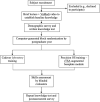Comparing Skill Acquisition and Validity of Immersive Virtual Reality with Cadaver Laboratory Sessions in Training for Reverse Total Shoulder Arthroplasty
- PMID: 37415724
- PMCID: PMC10319363
- DOI: 10.2106/JBJS.OA.22.00141
Comparing Skill Acquisition and Validity of Immersive Virtual Reality with Cadaver Laboratory Sessions in Training for Reverse Total Shoulder Arthroplasty
Abstract
Immersive virtual reality (iVR) allows surgical trainees to practice skills without risking harm to patients or the need for cadaveric training resources. However, iVR has never been directly compared with cadaver training, the longtime gold standard for surgical skill training. We aimed to compare skill acquisition using cadaver laboratory and iVR training methods for augmented baseplate implantation during reverse total shoulder arthroplasty (rTSA).
Methods: In a randomized controlled trial, junior orthopaedic surgery residents were assigned to a 1-hour training with either iVR or a cadaveric laboratory session with shoulder specimens. Before training, all participants viewed an overview lecture and technique video demonstrating key steps of augmented baseplate implantation for rTSA. Participants were assessed by a blinded evaluator using validated competency checklists during cadaveric glenoid baseplate implantation. Continuous and categorial variables were analyzed using the 2-sample t test and Fisher exact test.
Results: Fourteen junior residents (3 incoming matched postgraduate year [PGY1], 6 PGY1s, 1 PGY2, and 4 PGY3s) were randomized to training with either iVR (n = 6) or cadaver laboratory (n = 8). There were no significant differences in demographic data, previous experience with rTSA, or previous use of iVR (p > 0.05). There were no significant difference in total Objective Structured Assessment of Technical Skill score (91.2% [15.2] vs. 93.25% [6.32], -0.1406 to 0.1823, p = 0.763), Global Rating Scale score (4.708 [0.459] vs. 4.609 [0.465], -0.647 to 0.450, p = 0.699), or time to completion (546 seconds [158] vs. 591 seconds [192], -176.3 to 266.8, p = 0.655) in cadaveric glenoid baseplate implantation. Average cost of iVR hardware and a 1-year software license was $4,900, and average cost of a single cadaver laboratory was $1,268.20 per resident.
Conclusions: Among junior orthopaedic residents, there is similar skill acquisition when training with either cadaver laboratory or iVR. Although additional research into this field is needed, iVR may provide an important and cost-effective tool in surgical education.
Clinical relevance: Emerging simulation and iVR technology simulation in surgical training programs can increase access to effective and high-level surgical training across the globe and improve quality of care.
Copyright © 2023 The Authors. Published by The Journal of Bone and Joint Surgery, Incorporated. All rights reserved.
Figures
References
-
- Lohre R, Bois AJ, Athwal GS, Goel DP; Canadian Shoulder and Elbow Society (CSES). Improved complex skill acquisition by immersive virtual reality training: a randomized controlled trial. J Bone Joint Surg Am. 2020;102(6):e26. - PubMed
-
- Logishetty K, Rudran B, Cobb JP. Virtual reality training improves trainee performance in total hip arthroplasty: a randomized controlled trial. Bone Joint J. 2019;101-B(12):1585-92. - PubMed
-
- Butler A, Olson T, Koehler R, Nicandri G. Do the skills acquired by novice surgeons using anatomic dry models transfer effectively to the task of diagnostic knee arthroscopy performed on cadaveric specimens? J Bone Joint Surg Am. 2013;95(3):e15(1-8). - PubMed
Publication types
LinkOut - more resources
Full Text Sources


